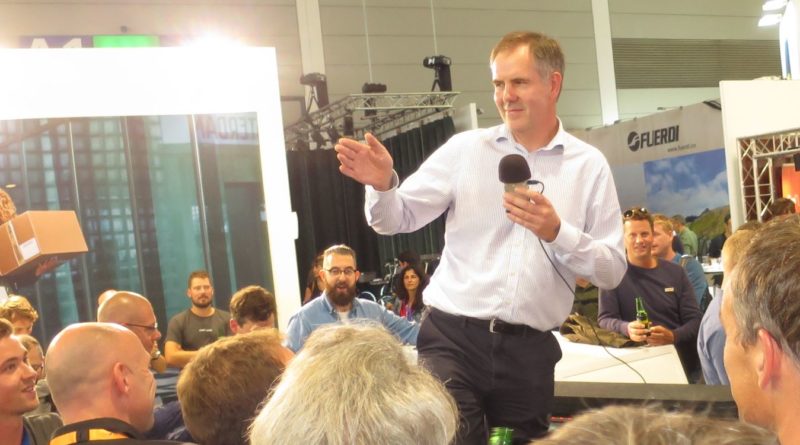Kevin Mayne: “The bike industry should prepare for political loosening of purse strings”
With each passing year it’s worthwhile taking a step back to look at the big picture on bike industry progress. With active travel momentum often held up by political will and funding shortfalls, we check in with Kevin Mayne, CEO at Cycling Industries Europe to understand why 2022 might be a breakthrough year…
Historically the bike industry has not always given the best account of itself. It’s not for a lack of wishing to, nor any lack of credibility or professionalism. No, we just haven’t been very good at collectively sharing and as a consequence of not knocking our heads together, pooling our insights and putting on a united front, it could be argued that opportunities have been missed to turn heads when it mattered.
Cycling Industries Europe comes to this year’s Eurobike once again charged with sitting company leaders, working groups and investors into the industry down in order to build a consensus on the available opportunities and shortcomings of a collaborative effort to move the needle in the political sphere. As we all know, the phrase ‘build it and they will come’ is time proven wherever in the world political will has warmed to cycling for transport. In this chicken and egg game, funding only flows freely once the right hands have been shaken. Politicians charged with challenging the status quo of motor dominance have to be brave by nature to drive and stand firm on change. After all, the motoring world has long been able to demonstrate its economic worth.
Why, then, in 2022 might the cycling world find itself at a junction where appetite for change has never been greater?
Kevin Mayne, CEO at Cycling Industries Europe is arguably the closest within the cycling industry to the coal face of politics in Europe. His industry-backed organisation has become the focal point of data collection, knowledge sharing and organised advocacy in action. There are of course many reasons why cycling for transport finds itself turning new heads, but we start with a very present problem; Russia’s war.
“There is a need to get out of Russian oil now. The European Commission hopes to do so inside 18 months. The level of sanctions and the speed at which they have come through is unprecedented. Add to this the Fit for 55 ambition that is pressing for a 55% net greenhouse gas emissions reduction by 2030 – the need to find alternative, cleaner transport has vastly accelerated,” starts Mayne.
A live policy summit held during May by Cycling Industries Europe and its partners attracted EU institutions to the discussion table. Here cycling’s case as a ready-made solution to the crisis, that requires little in the way of innovation and as such relatively low investment, was made. The pandemic, said Mayne, had by this time already demonstrated what a rapid and impactful change cycling’s enhanced modal share had made globally. The case had been made during a once in a lifetime demo by pure chance and the evidence for pursuing active travel became clear.
 “We don’t need to reinvent the wheel to get cities ready for a meaningful shift. From right now progress can be accelerated simply by having Governments invest in infrastructure; this is proven to stimulate modal share changes. We almost didn’t need to say so at the summit. Where you have new infrastructure you get the fastest growth. Our message to EU member states now is simply: how fast can you do this? During Covid we spent €1 billion across Europe and we now know the EU has a further €2 billion pledged in recovery plans that build in active travel schemes. This is before we get into details of the Green Deal. The bike industry should prepare for this political loosening of purse strings.”
“We don’t need to reinvent the wheel to get cities ready for a meaningful shift. From right now progress can be accelerated simply by having Governments invest in infrastructure; this is proven to stimulate modal share changes. We almost didn’t need to say so at the summit. Where you have new infrastructure you get the fastest growth. Our message to EU member states now is simply: how fast can you do this? During Covid we spent €1 billion across Europe and we now know the EU has a further €2 billion pledged in recovery plans that build in active travel schemes. This is before we get into details of the Green Deal. The bike industry should prepare for this political loosening of purse strings.”
To get to this point has taken collaboration. As alluded to earlier, the cycling industry has not always been so keen to pool its insights, some preferring to keep competitors in the dark and all cards close to the chest. That’s the barrier Cycling Industries Europe has broken down with an all ships rise together mantra, itself becoming the hub of insight of European trade organisations and manufacturers.
“To access the support of policy makers we needed to be better organised. Speaking about the industry, we need our own supply chain strategy, among other things. As a collective we need to be clear on which components we have a problem with and to be supported by data; then we can access assistance. We made a start in pandemic. What people found striking at the Summit was the now consistent voice from companies saying ‘we get it’. There was an understanding that we need to learn new skills on collaboration and data sharing. Being organised as a unit gets us taken seriously,” explains Mayne.
What the bike market as a whole has perhaps lacked is an organised digitalisation component that tracks cross border supply status, something which the car industry, for example, has. With better tooling to quantify a broad status for the industry it is easier to make the case for investment in industry and supporting infrastructure.
Cycling Industries Europe, hoping to get a handle on the issue, commissioned a research project on the supply chain with initial figures showing demand at the consumer end declined slightly post Covid, which will have been seen as inevitable. Meanwhile, demand on components in the supply chain is still going up, so there’s a mismatch. “We don’t have transparency on where those orders are, which means we don’t have a good collaboration on the overall availability of frames, wheels, or tyres, for example. People were seemingly randomly buying where they perceive a weakness. Missing full transparency can be costly,” explains Mayne.

In this moment the industry has taken a breath and plateaued, but all bets are on a resumption of a steep growth curve. Lots of those forecasts are being made by the European bike industry, where manufacturing of electric bikes and the investments attached have grown and grown. To name just a few brands that have spent big with a view to challenging for market share, Riese & Müller has added two production units, KTM Bicycles has again added production halls and Cube’s ever-growing Waldershof production (pictured right) has once again added capacity. As almost all producers will testify, a 90% completed bike is still unable to be sold, so plugging supply gaps has become a critical mission and one that is desired to be fulfilled closer to domestic markets.
“We will need to reshore many things in order to meet the sales forecast to 2030 and even more so if European Commission really push on infrastructure. We are talking about getting to 30 million bike units sold rather than the 22 million sold across the EU in 2020 and we are absolutely confident the growth curve will resume,” says Mayne.
Where strong business prospects based on mega trends exist heads are often turned in the investment world. Last time CI.N spoke with Kevin he notably said, “I’ve had some remarkable conversations with investment bankers who would like to put money in to the cycling industry but are unable to choose where to start.” Having since guided bike businesses and potential backers via various seminars, we’re keen to understand just who has eyes for the cycling business and why. More importantly, is our main mobility rival one of those muscling in and how will being spectacularly well-financed help car makers get a leg up?
“The automotive world will always defend its own interests, but despite that what I’ve seen is that there’s an openness within the European Commission to hear new voices. At the summit there was an epiphany where somebody in the political sphere admitted they had not considered that you could protect automotive jobs that may be vulnerable by transferring the skills to the cycling world. They were thinking like-for-like and not about the wider ecosystems’ similarities. We made clear if we follow growth curve to 2030 the bike trade could create 200,000 jobs, which coincidentally exactly the number of car industry folk projected to be lost in the component supply sector. We in cycling need component supply know how,” explains Mayne.
Cycling Industries Europe’s many working groups are the cogs that turn the wheel in research terms and it would be remiss not to turn some attention to a growth industry that was once a niche, but is now attracting some of the world’s largest businesses. The cargo bike working group’s efforts to pool data and understanding has landed the segment in the spotlight of the EU’s new REPowerEU plan.
Having estimated that increased cycling levels could quickly reduce the need for Russian oil by about 12%, CIE were pleased to see various measures announced in the policy document that could be a boon for the maturing industry.
Mayne says: “On this list in second spot we saw the cargo bike featured, specifically the promotion and incentivising of last-mile delivery in this way. This has universal backing and will reduce van use in cities, plus get us away from diesel use, which is not easy. Van traffic is up there amongst the fastest growing traffic form, but it’s very hard to make them more efficient. It’s noteworthy here that Amazon’s logistics arm is now an associate member of ours and tapping into our cargo bike working group’s knowledge. They wanted to get ahead of the game, something our combined knowledge enables.”
To bring meaningful change, the bicycle economy and local authorities have a common but now seemingly surmountable problem – both cash and will power to enable progress must flow. With Mayne’s assertion that sentiment is warming fast, let’s have a final thought.
“Cycling is able to bring about progress on many fronts so much faster than other segments, be it EVs, Hydrogen, Biofuels or something else. We have the technology and we have the proof that cycling for transport is faster, cleaner and cheaper for individuals and businesses. The Commission are onside with that message. At this stage other industries have that strong strategic assistance, but cycling has yet to be backed in quite the same way. As long as our combined voice is consistent and we learn new skills on collaboration and data sharing I can feel that support is incoming.”



